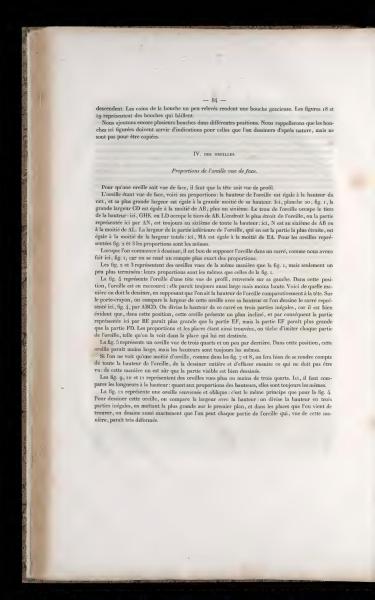— 84 —
The corners of the mouth raised a little make the mouth graceful. Figures 18 and 19 represent yawning mouths.
We are adding more mouths in different positions. We remind you that the mouths shown here should serve as indications for those to be drawn from nature, but are not for copying.
IV. THE EARS.
Proportions of the ear seen from the front.
For an ear to be seen from the front, the head must be viewed in profile.
When viewed from the front, the proportions of the ear are as follows: the height of the ear is equal to the height of the nose, and its widest part equals the greater half of its height. Here, plate 30, fig. 1, the maximum width CD is equal to half of AB, plus one sixth. The ear hole occupies one third of the height; here, GHK or LD occupies one third of AB. The most narrow part of the ear, shown here as AN, is always at one sixth of the total height: here, N is at one sixth of AB or at half of AL. The width of the lower part of the ear, which is its narrowest point, is equal to half the total width: here, MA is equal to half of EA. For the ears shown in fig. 3 and 7, the proportions are the same.
When starting to draw, it's good to imagine the ear in a square, as we did here, fig. 7, as it gives a more accurate understanding of the proportions.
Figures 2 and 3 represent ears viewed similarly to fig. 1, but slightly more extended: their proportions are the same as those of fig. 1.
Figure 4 represents the ear of a head viewed in profile, reversed to the left. In this position, the ear is foreshortened: it seems as wide but shorter. Here's how to draw it, assuming one has the height of the ear in comparison to the height of the pencil-holder, compare the width of this ear with its height, and draw the square shown in fig. 4, by ABCD. The height of this square is divided into three unequal parts, as it is clear that, in this position, this ear presents an inclined plane, and therefore the part shown here by BE appears larger than the part EF, but part EF appears larger than part FG. The proportions and positions being found in this way, replicate each part of the ear as seen in the designated position.
Figure 5 represents an ear seen in three-quarters and slightly overturned. In this position, the ear appears less wide, but the heights are always the same.
If only one half of the ear is visible, as in figures 7 and 8, it's best to understand the full height of the ear, draw it entire, and then erase what shouldn't be seen: this way, one is sure the visible part is well drawn.
Figures 9, 10, and 11 represent ears viewed more or less from three-quarters. Here, compare the lengths to the height: regarding the height proportions, they remain always the same.
Figure 12 represents an ear reversed and oblique: it follows the same principle as in fig. 4. To draw this ear, compare the width to the height: divide the height into three unequal parts, placing the largest in the foreground, and in the places found, draw each part of the ear as exactly as one can, which when viewed in this manner, appears very distorted.
Translation Notes:
- "Raccourci" is a term used in art to describe the visual technique of depicting an object or figure in perspective. It translates as "foreshortened" in English.
This text explains drawing the human ear, focusing on viewing and portraying ear proportions accurately. It provides instructions on depicting ears from different angles, including from the front and profile, and how to understand dimensions by conceptualizing them within geometric shapes. The explanations emphasize the importance of comparison between various parts and using foreshortening techniques when needed.
